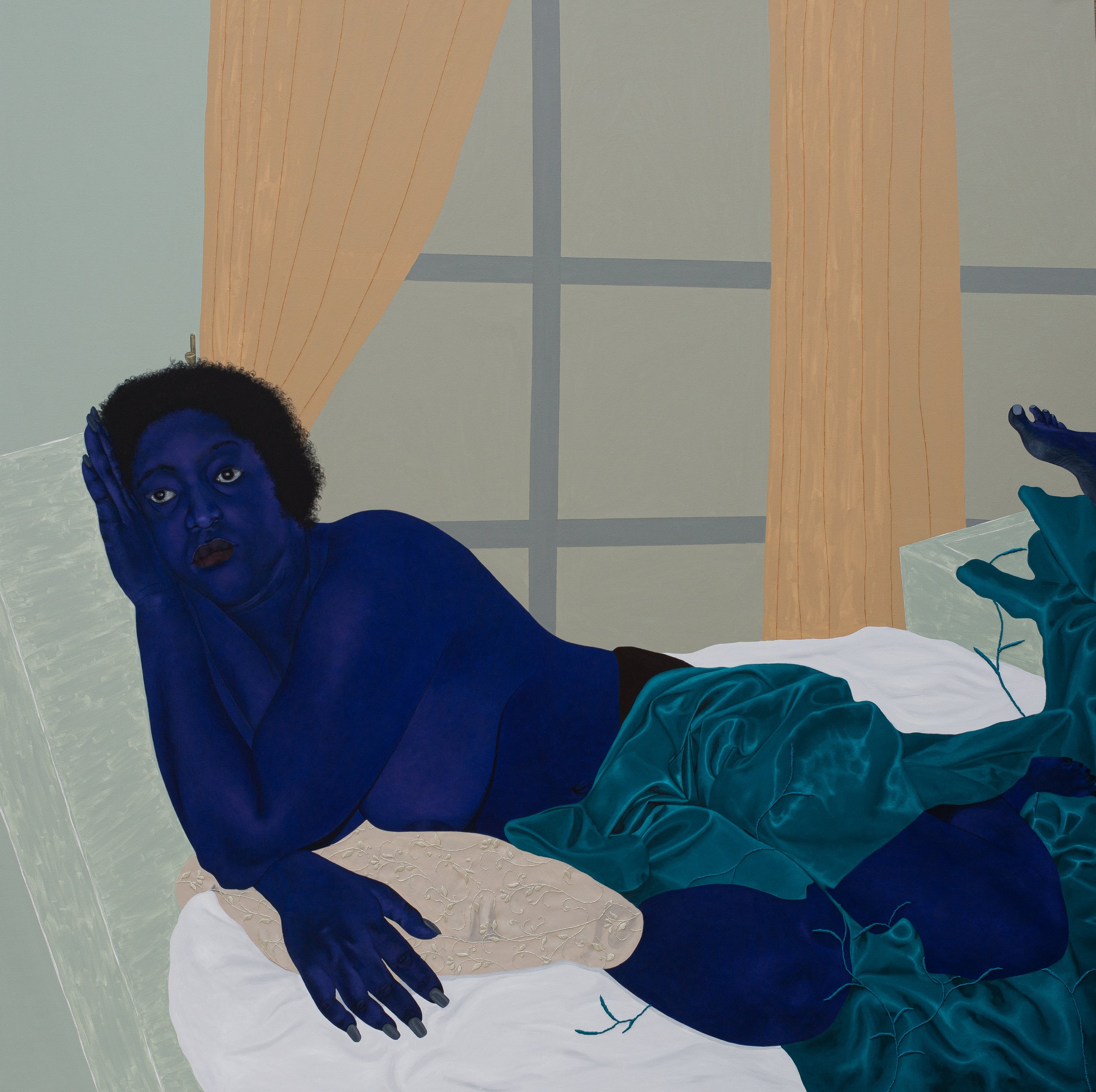Stacey Gillian Abe
Stacey Gillian Abe’s radiant portraits draw on her autobiographical experiences in order to deconstruct and rebuild prevailing representations of Black womanhood. Abe’s unique interpretation of space and the body opens up a space of engagement with the viewer that facilitates a deep connection with her subjects.
Stacey Gillian Abe. Image by Eric Okurut.
For more of Abe’s work, please visit her website or her Instagram.
Abe holds a Bachelor’s degree in Art and Industrial Design from Kyambogo University in Kampala, Uganda. But she does not track the beginning of her artistic life to any specific date. Rather she recalls an urge to produce creatively from a young age. Art became her “happy place,” as she describes it, a place nurtured and driven forward by her innate passion for creating as well as the fruits of her memory.
The personal elements of her work translate into paintings untethered within temporal reality, instead taking up residence in the realm of the imaginary. For example, Last Night (2023) depicts a figure shaded in Abe’s distinct indigo hue, looking directly at the viewer. The only hints of an existing place are found in the thin lines behind her, which draw focus to the figure and her interiority. The piece – along with A Line From My Favorite Novel (2021) and The Farmer’s Daughter (2022) – spotlights the nostalgia of Abe’s teenage years by highlighting the people who defined it, from those she met in an all-girls boarding school to shared memories between her, her sister and her mother.
Last Night, 2023. Acrylic and hand-embroidered details on canvas. 150 x 200 cm. Image courtesy of the artist.
In a similar vein to artists of the past who have become associated with a single colour – like Yves Klein’s famously patented International Klein Blue – Abe employs a rich, vibrant indigo to compose her figures. In this way, her works take on a distinctly mystical and surreal element, allowing for a multi-faceted probe into conventions of representation.
According to Abe, “Indigo for a skin tone in my work signifies a tribe, a breed of black, a people that are not limited to social, economic, cultural or political and historic constraints. It is being unapologetic and expressing vulnerability selflessly.” [1] Thus, the colour choice consciously opens another dimension specific to Abe’s oeuvre where she can explore and envision social change.
The Farmer’s Daughter, 2022. Acrylic on canvas. 150 x 200 cm. Image courtesy of the artist.
Additionally, a feeling of vulnerability permeates Abe’s figures, whether through their unflinching eye contact with the viewer or their intimate posing. The Farmer’s Daughter exemplifies this, as a woman’s body unabashedly presents itself to the viewer. Instead of being confronted with her face, we are confronted with her genitals. Abe seamlessly creates contrasts between space and engagement, toeing the line between boundaries and invitations.
What comes to mind is a broader art-historical perspective onto Abe’s work: art historian Tayler Friar describes the significance of the figure’s act in The Farmer’s Daughter in “The Black Female Body: Representation of the Erotic in Contemporary Visual Art in Africa”: “history illuminates the journey of the black woman, whose physique has been beaten, broken, stolen and shamed while simultaneously glorified through fixed stereotypes that control and limit how she exists in society.” [2] In other words, throughout history and art history, oppressive forces have worked to box Black women into repressive categories and dictate for them what their bodies and lives ought to look like. Friar outlines the many ways artists counter these narratives by representations of the body, summarised with the quote, “traditionally diminishing labels are being reclaimed through modern expression to re-establish images of the black female body as a source of empowerment.” [3]
When we apply this broad perspective, The Farmer’s Daughter can be considered to partake in this pushback, claiming and asserting the space that, historically, Black women were not allowed to occupy. It, along with much of Abe’s work, infuses tenderness and sensuality into that space, allowing them room to breathe. As Abe puts it, “through my work, I am able to re-imagine an alternative future where, in these worlds I create, we are free, unapologetic and provocative, taking up spaces and positions only imaginable.” [4] Furthermore, the figures’ link to Abe’s personal history individualises them and returns them to the deeply intimate domain of her own life.
A Line From My Favorite Novel, 2021. Acrylic on canvas. 150 x 130 cm. Image courtesy of the artist.
Along with her gentle representation of bodies, Abe’s subjects betray an emotional depth revealed through their eyes and their facial expressions. The woman in A Line From My Favorite Novel is both pleading and questioning, confronting the viewer calmly yet suggestively. It builds upon the theme of teenage nostalgia and embodies a personal and universal practice, exemplifying the heart of Abe’s work.
Currently, Abe is back in her studio, building on her practice and developing a new body of work. Her most recent exhibition was an April 2023 solo show at the Expo Chicago, an international Modern and Contemporary art exhibition with Unit London.
Atoho’s Guest 1, 2023. Acrylic and hand-embroidered details on canvas. 200 x 200 cm. Image courtesy of the artist.
Footnotes:
UNIT London. “Stacey Gillian Abe.” https://unitlondon.com/artists/stacey-gillian-abe/.
Friar, Tayler. “The Black Female Body: Representation of the Erotic in Contemporary Visual Art in Africa.” Revue d’etudes anglophones 19, no. 19.1 (December 2021): np.
Friar, “The Black Female Body,” np.
UNIT London. “Stacey Gillian Abe.”
Gabriella Hetu
Emerging Artist Co-Editor, MADE IN BED






